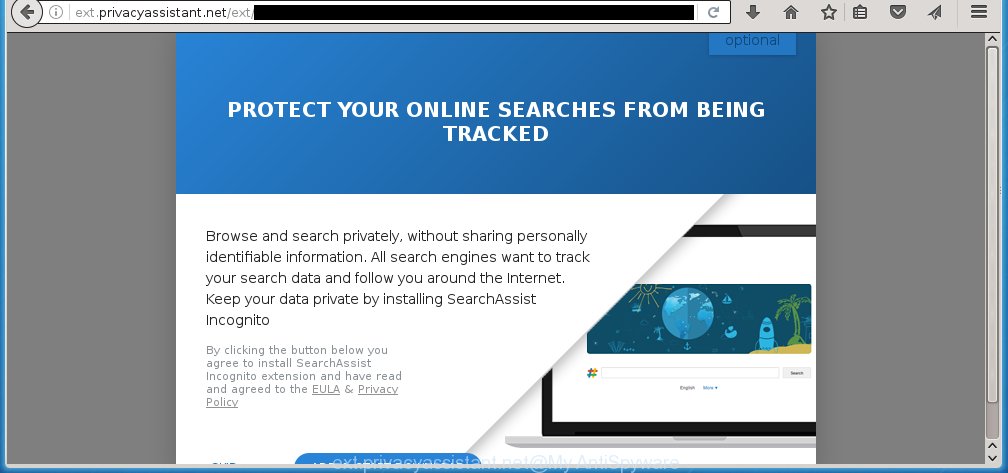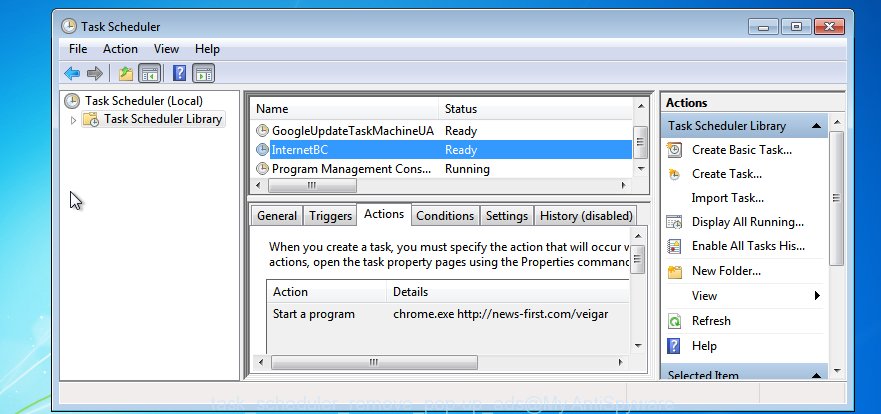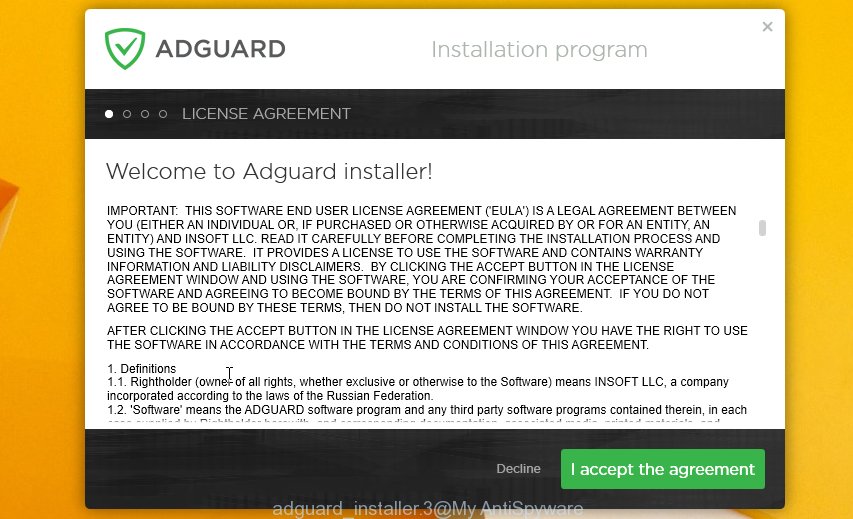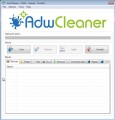There are many types of malware and one of them is adware (sometimes called ‘ad-supported’ software). The adware, which causes the appearance of ext.privacyassistant.net pop-ups or the redirect to this annoying web site, have a negative impact on the functioning of your computer. It modifies personal computer settings, generates a large amount of various ads, slows down the Chrome, Internet Explorer, FF and Microsoft Edge and the speed of your internet connection. Moreover, it may lead to the fact that web pages are slow to load and the browser interface can even freeze. The main function of the adware is showing advertisements, so it may reroute your web-browser to an unwanted web site like ext.privacyassistant.net, instead of the one that you want to visit. Even if you try to type an address into the web browser’s address bar, then the web browser is anyway will show an unwanted ad web-site.

http://ext.privacyassistant.net/ext/lp? …
The ‘ad-supported’ software usually affects only the Firefox, Chrome, Internet Explorer and Microsoft Edge by changing the web browser’s settings or installing a dangerous extensions (addons). Moreover, possible situations, when any other browsers will be affected too. The ad-supported software will perform a scan of the PC system for internet browser shortcuts and modify them without your permission. When it infects the web browser shortcuts, it will add the argument like ‘http://site.address’ into Target property. So, each time you launch the web-browser, you will see an unwanted ext.privacyassistant.net page.
What is more, the ad supported software may open advertisements depend on a web-page that you are visiting. That is, it is clear that this ad-supported software, without your permission, steals your private information such as: your ip address, what is a web page you are viewing now, what you are looking for on the Internet, which links you are clicking, and much, much more. The adware may monetize its functionality by collecting data from your browsing sessions and selling it to third party companies. This puts your personal information at a security risk.
Instructions, which is shown below, will allow you to clean your computer from the ad-supported software as well as remove ext.privacyassistant.net unwanted pop-up ads from the FF, Chrome, Internet Explorer and Edge and other web browsers.
How does ext.privacyassistant.net ads get installed onto machine
Just as the beginning of this blog post, if you have ever seen the ext.privacyassistant.net web site appear in your web browser, it means your machine has been infected with the ad-supported software. Most often adware is bundled with freeware. So, think back, have you ever download and start any freeware? Because most users, in the Setup Wizard, simply click the Next button and do not read any information such as ‘Terms of use’ and ‘Software license’. This leads to the fact that the computer is infected, the internet browser’s configured to display lots of the ext.privacyassistant.net unwanted ads. Even removing the free programs that contains this ad supported software, the unwanted ads does not disappear. Therefore, you must follow the step-by-step instructions below to clean your computer from the adware and thereby remove ext.privacyassistant.net advertisements.
How to manually remove ext.privacyassistant.net
The simple answer is right here on this page. We have put together simplicity and efficiency. It will allow you easily to clean your computer of adware. Moreover, you can choose manual or automatic removal method. If you are familiar with the system then use manual removal, otherwise use the free anti-malware tool designed specifically to remove ‘ad-supported’ software that causes unwanted ext.privacyassistant.net redirect. Of course, you can combine both methods. Read this manual carefully, bookmark or print it, because you may need to close your browser or reboot your personal computer.
- Delete suspicious and unknown software by using Windows Control Panel
- Disinfect the browser’s shortcuts to remove ext.privacyassistant.net redirect
- Get rid of ext.privacyassistant.net pop-ups from Firefox
- Get rid of ext.privacyassistant.net ads from Google Chrome
- Get rid of ext.privacyassistant.net from Internet Explorer
- Remove unwanted Scheduled Tasks
Delete suspicious and unknown software by using Windows Control Panel
The best way to begin the system cleanup is to remove unknown and suspicious applications. Using the Windows Control Panel you can do this quickly and easily. This step, in spite of its simplicity, should not be ignored, because the removing of unneeded applications can clean up your web browser from pop-ups, hijackers and so on.
- If you are using Windows 8, 8.1 or 10 then press Windows key, click Search. Type “Control panel”and press Enter.
- If you are using Windows XP, Vista, 7, then press “Start” button and click “Control Panel”.
- It’ll open the Windows Control Panel.
- Click “Uninstall a program” under Programs category.
- You will see a list of all installed programs.
- Scroll through the all list, and remove suspicious and unknown programs. To quickly find the latest installed software, we recommend sort programs by date.
See more details in the video instructions below.
Disinfect the browser’s shortcuts to remove ext.privacyassistant.net redirect
Once the adware is started, it can also change the internet browser’s shortcuts, adding an argument such as “http://site.address” into the Target field. Due to this, every time you launch the web-browser, it will be redirected to an annoying advertisements.
To clear the web-browser shortcut, right-click to it and select Properties. On the Shortcut tab, locate the Target field. Click inside, you will see a vertical line – arrow pointer, move it (using -> arrow key on your keyboard) to the right as possible. You will see a text that begins with “http://” that has been added here. You need to remove it.

When the argument is removed, press the OK button. You need to clean all shortcuts of all your internet browsers, as they may be infected too.
Get rid of ext.privacyassistant.net pop-ups from Firefox
First, launch the Mozilla Firefox. Next, click the button in the form of three horizontal stripes (![]() ). It will open the drop-down menu. Next, click the “Help” button (
). It will open the drop-down menu. Next, click the “Help” button (![]() ).
).

In the Help menu, click the “Troubleshooting Information”. In the upper-right corner of the “Troubleshooting Information” page, click “Refresh Firefox” button.

Confirm your action, press the “Refresh Firefox”.
Get rid of ext.privacyassistant.net ads from Google Chrome
Open the Chrome menu by clicking on the button in the form of three horizontal stripes (![]() ). It opens the drop-down menu. Next, click the “Settings” option.
). It opens the drop-down menu. Next, click the “Settings” option.

Scroll down to the bottom of the page and click on the “Show advanced settings” link. Now scroll down until the Reset settings section is visible, as shown in the figure below and press the “Reset settings” button.

Confirm your action, click the “Reset” button.
Get rid of ext.privacyassistant.net from Internet Explorer
First, start the IE, then click ![]() button. Next, click “Internet Options” as shown below.
button. Next, click “Internet Options” as shown below.

In the “Internet Options” screen select the Advanced tab. Next, click the “Reset” button. The Internet Explorer will open the “Reset Internet Explorer” settings dialog box. Select the “Delete personal settings” check box and press Reset button.

You will now need to restart your system for the changes to take effect. It will restore the Microsoft Internet Explorer’s settings like start page and search provider by default to default state, disable ad-supported web browser’s extensions and thereby remove the redirect to ext.privacyassistant.net annoying web page.
Remove unwanted Scheduled Tasks
If the annoying ext.privacyassistant.net page opens automatically on Windows startup or at equal time intervals, then you need to check the Task Scheduler Library and remove all the tasks that have been created by malicious software.
Press Windows and R keys on the keyboard simultaneously. This opens a prompt that titled with Run. In the text field, type “taskschd.msc” (without the quotes) and click OK. Task Scheduler window opens. In the left-hand side, click “Task Scheduler Library”, like below.

Task scheduler
In the middle part you will see a list of installed tasks. Select the first task, its properties will be show just below automatically. Next, click the Actions tab. Pay attention to that it launches on your PC system. Found something like “explorer.exe http://site.address” or “chrome.exe http://site.address”, then you need get rid of it. If you are not sure that executes the task, check it through a search engine. If it’s a component of the adware, then this task also should be removed.
Having defined the task that you want to delete, then click on it with the right mouse button and select Delete as shown in the figure below.

Delete a task
Repeat this step, if you have found a few tasks that have been created by adware. Once is done, close the Task Scheduler window.
How to remove ext.privacyassistant.net redirect with free malware remover
Remove ext.privacyassistant.net advertisements manually is difficult and often the adware is not completely removed. Therefore, we recommend you to use the Malwarebytes Free which are completely clean your machine. Moreover, the free program will help you to remove malware, internet browser hijacker and toolbars that your system may be infected too.
- Download Malwarebytes from the link below. Malwarebytes Anti-malware
327766 downloads
Author: Malwarebytes
Category: Security tools
Update: April 15, 2020
- Close all software and windows on your machine. Open the directory in which you saved it. Double-click on the icon that’s named mb3-setup.
- This will launch the setup of Malwarebytes. Next, click Next button and follow the prompts.
- Once install is finished, press on the “Scan Now” button to begin checking your PC system for the adware that redirects your web-browser to the ext.privacyassistant.net annoying web-site. This process can take some time, so please be patient.
- When it has finished scanning your system, make sure all entries have “checkmark” and click “Quarantine Selected”. When the disinfection is done, you may be prompted to reboot your PC.
These steps above are shown in detail in the following video guide.
Block ext.privacyassistant.net ads and other annoying web pages
To increase your security and protect your personal computer against new unwanted advertisements and malicious web sites, you need to use application that blocks access to malicious ads and sites. Moreover, the program can block the display of intrusive advertising, that also leads to faster loading of pages and reduce the consumption of web traffic.
Download AdGuard program by clicking on the following link.
27048 downloads
Version: 6.4
Author: © Adguard
Category: Security tools
Update: November 15, 2018
When downloading is complete, launch the file named adguardInstaller. You will see the “Setup Wizard” screen like below.

Follow the prompts. When the install is complete, you will see a window as shown in the following image.

You can click “Skip” to close the installation program and use the default settings, or press “Get Started” button to see an quick tutorial which will assist you get to know AdGuard better.
In most cases, the default settings are enough and you do not need to change anything. Each time, when you start your system, AdGuard will run automatically and block pop-up ads, web pages like ext.privacyassistant.net, as well as other malicious or misleading web pages. For an overview of all the features of the program, or to change its settings you can simply double-click on the AdGuard icon, that is located on your Windows desktop.
If the problem with ext.privacyassistant.net ads is still remained
If MalwareBytes cannot delete ext.privacyassistant.net ads, then we suggests to use the AdwCleaner. AdwCleaner is a free removal tool for adware, browser hijackers, PUPs, toolbars.

- Download AdwCleaner from the link below. AdwCleaner download
225802 downloads
Version: 8.4.1
Author: Xplode, MalwareBytes
Category: Security tools
Update: October 5, 2024
- Double click the AdwCleaner icon. Once the tool is started the main screen will appear as shown on the image above.
- Now, click the “Scan” button to perform a system scan for the ‘ad-supported’ software which generates ext.privacyassistant.net ads.
- Once the checking is finished, AdwCleaner will open a scan report. Review the report and then press “Clean” button. It will display a dialog box, press “OK” button.
The following video explains the instructions above on how to remove adware with AdwCleaner.
Finish words
After completing the step-by-step instructions shown above, your system should be clean from malware and adware. The Chrome, Internet Explorer, Mozilla Firefox and Microsoft Edge will no longer show ext.privacyassistant.net annoying advertisements or redirect you to unwanted web-sites. Unfortunately, if the steps does not help you, then you have caught a new type of adware, and then the best way – ask for help in our Spyware/Malware removal forum.


















